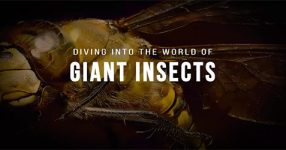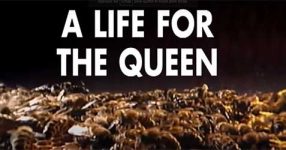In “The Tiny World Of Insects”, the focus begins with the touch me not Balsam, covering the Woodland floor in the Lake District. Each night, the leaves go limp, exuding excess moisture to adapt to waterlogged soils. The blooms unfurl, revealing seed pods that become the favorite food of the netted carpet moth caterpillar. Once thought extinct, the netted carpet moth survives in the Lake District, with touch me not Balsam being its sole source of sustenance. The surprise element lies in the touch me not Balsam’s seed heads, which explode, earning them the name “touch me not.” The caterpillars, however, seem oblivious to this explosive phenomenon, continuing to forage without warning.
Hot Rod Ants in Namib Desert
In the Namib Desert, the documentary shifts to the hot rod ants, defying the extreme heat as others seek refuge. Cleaning out their nest and constantly moving, they avoid standing still, which could lead to them frying in the scorching temperatures. The ants face challenges like navigating a minefield of cone-shaped death traps set by foreign larvae. The ant lion, a skilled predator, uses tactics like flinging sand to create an overlash, making escape seemingly impossible. The ants encounter a formidable opponent in a beetle armed with formic acid, mimicking a defenseless lizard to deter predators. The documentary unveils various insects’ chemical warfare strategies, with the bombardier beetle showcasing a remarkable ability to release boiling caustic liquid as a defensive mechanism.
Extraordinary Survival Skills
The narrative transitions to the New Zealand’s weta, a creature with an extraordinary ability to survive freezing temperatures. Endowed with special proteins preventing ice crystals from forming inside its cells, the weta showcases its talent in a specialized filming chamber. The documentary explores other insects’ survival skills, including the Antarctic’s Mountain Stoneweta, capable of tolerating over 80% of its body freezing solid. It underlines the diverse strategies insects employ to endure extreme conditions, emphasizing the intricate balance of nature.
Army Ants and Collective Behavior
The focus shifts to army ants, presenting them as a superorganism with collective behavior. A million-strong colony acts as one, possessing a sensory system of 2 million antennae, a living body skeleton, a defense system with soldier ants, and a coordinated approach to waste management. The ants employ a unique method of foraging, sending out a silent probe into the jungle, sweeping across the forest floor to find prey. The documentary showcases the army ants’ efficient raid front, where they pin down and tear apart prey, highlighting their collective strength and adaptability in the jungle ecosystem.
The Resilient Mountain Snowberry
The documentary explores the mountain snowberry in New Zealand, known for its incredible survival skills in extreme temperatures. The mountain snowberry can freeze over 80% of its body solid, defrost, and endure lethal temperatures day in and day out. The film captures its ability to survive freezing in a controlled environment and emphasizes how this ancient creature has adapted to New Zealand’s harsh conditions over 80 million years. The mountain snowberry’s resilience and survival tactics make it a fascinating subject in the world of insects.
Honey Bees, Japanese Bees, and the Battle Against Hornets
The focus turns to honey bees, depicting the intricate dynamics within a hive and the challenges faced during the autumn season. Japanese bees, known for their unique behavior, demonstrate patience and skill in dealing with hornet scouts. The documentary captures the intense battle between honey bees and hornets, showcasing the Japanese bees’ ability to lure and defeat hornet scouts without directly attacking them. The film underscores the importance of understanding insect behavior in beekeeping and the ancient tradition of keeping wild Japanese bees.
The Dark Side of Honey Ants
The narrative takes a darker turn with honey ants engaging in a preemptive strike on neighboring colonies. The film reveals the ruthless side of honey ants, eliminating competing nests in a killing spree to establish dominance. The documentary portrays the complex social structure of honey ants, including the sacrifices made by workers and the resilience of dominant royals. As the empire expands underground, the honey ants’ actions unfold with a blend of brutality and survival instincts.
Locust Swarms: Planet Earth’s Spectacle
The documentary captures the spectacular phenomenon of locust swarms, emphasizing their rapid development in favorable conditions. The hoppers, flightless young locusts, join swarms that can grow to billions in size. The film showcases the massive plagues that form, consuming everything in their path. It highlights the rarity of witnessing such a spectacle on this scale and the transient nature of these colossal swarms, leaving behind only the sound of the desert wind once the food is depleted.
Silk Moths and Metamorphosis
The final segment delves into the intricate process of metamorphosis, focusing on silk moths. The documentary showcases the caterpillar’s transformation into a chrysalis, emphasizing the delicate but crucial steps involved. The silk moth’s ability to anchor itself and undergo a remarkable transformation underscores the beauty and complexity of insect metamorphosis. The documentary concludes by highlighting the diverse and extraordinary world of insects, showcasing their survival strategies, collective behaviors, and the intricate dance of life in the tiny world they inhabit.












